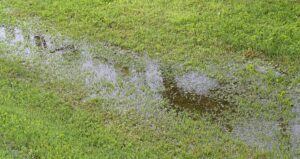In Houston, Texas, the average water usage for a residential sprinkler system from April to August can vary depending on the size of the lawn, the type of plants, and the efficiency of the irrigation system. However, general estimates suggest that for a typical residential property with a lawn size of about 7,000 to 10,000 square feet, residents often water their lawns 2-3 times per week during the hot months. A standard sprinkler system can use around 1,500 to 3,000 gallons per watering session. Given these factors, a typical household might use: 3,000 to 9,000 gallons per week and over five months (April to August) approximately 60,000 to 180,000 gallons of water!
These figures can be higher or lower depending on individual practices, square feet being covered, local watering restrictions, and the efficiency of the sprinkler system.
When you keep this in mind, you can see how important it is to ensure your sprinkler system is working efficiently and not using more water than it should. Here are some signs that your sprinkler system is overwatering your lawn or garden.
Signs Your Sprinkler System is Overwatering
A well-maintained lawn is a point of pride for many homeowners, especially in regions like Houston, Texas, where the summer heat can be relentless. However, achieving that lush, green lawn isn’t just about watering often; it’s about watering correctly. Overwatering can be just as damaging as underwatering, leading to various issues that can harm your lawn and landscape. Here are the key signs that your sprinkler system might be overwatering.
- Soggy or Spongy Lawn
One of the most obvious signs of overwatering is a soggy or spongy lawn. When you walk across your grass and it feels squishy or like you’re stepping on a sponge, it’s a clear indicator that there’s too much water in the soil. This excess moisture can lead to root rot, a condition where the grass roots suffocate and begin to decay due to a lack of oxygen.
- Mushroom and Fungal Growth
If you notice an unusual number of mushrooms or other fungi popping up in your yard, your sprinkler system may be to blame. Fungi thrive in moist environments, and overwatering creates the perfect conditions for these unwanted guests. While mushrooms themselves aren’t necessarily harmful to your lawn, their presence suggests that your soil is staying too wet for too long, which can lead to more serious issues.
- Yellowing Grass
Contrary to what you might expect, yellowing grass can be a sign of overwatering rather than a lack of water. When the soil is constantly saturated, grass roots can’t get the oxygen they need to stay healthy. As a result, the grass may turn yellow and start to thin out. Over time, this can lead to dead patches and a weakened lawn that’s more susceptible to disease.
- Runoff and Puddling
If you notice water running off your lawn into the street or forming large puddles, it’s a sign that your sprinkler system is delivering more water than the soil can absorb. This not only wastes water but can also lead to erosion and nutrient loss in your soil, leaving your grass with fewer resources to thrive.
- Increased Weed Growth
Overwatering can encourage the growth of weeds, which often thrive in moist conditions. If you find that you’re constantly battling weeds, particularly broadleaf varieties like clover and dandelions, your sprinkler system might be providing them with an ideal environment to take over your lawn.
- Frequent Pest Issues
Standing water and overly moist soil can attract pests like mosquitoes, which lay their eggs in stagnant water, and grubs, which thrive in damp environments. If you’re dealing with an increase in lawn pests, it might be time to reassess your watering schedule.
- High Water Bills
If your water bill spikes during the spring and summer months, it could be a sign that your sprinkler system is using more water than necessary. While some increase in water usage is expected during these months, a significant jump could indicate overwatering.
How to Correct Overwatering
If you recognize any of the above signs, it’s important to adjust your watering habits to avoid further damage to your lawn and landscape. Here are some tips to help you correct overwatering:
Check Your Watering Schedule: Water deeply but infrequently. Most lawns only need about 1 to 1.5 inches of water per week, including rainfall. Adjust your sprinkler system to water less often but for longer periods to encourage deep root growth.
Inspect Your Sprinkler System: Ensure that your sprinkler heads are functioning correctly and that there are no leaks. Broken or misaligned sprinkler heads can lead to uneven watering, with some areas receiving too much water.
Install a Rain Sensor: A rain sensor can automatically shut off your sprinkler system when it detects rainfall, preventing unnecessary watering.
Aerate Your Lawn: Aerating helps improve soil drainage and allows water to penetrate more deeply, reducing the likelihood of overwatering.
Schedule Maintenance: Having professionals inspect and service your sprinkler system at least twice a year will help ensure your system is watering correctly.
Overwatering is a common issue that can have serious consequences for your lawn. By being aware of the signs and taking steps to correct your watering habits, you can maintain a healthy, vibrant lawn without wasting water or encouraging pests and disease. Remember, when it comes to lawn care, more water isn’t always better!
At Triple Green, we are dedicated to providing comprehensive irrigation system services that meet the highest standards of quality and efficiency. Whether you need repairs, upgrades, or maintenance, our team of experts is here to help you achieve a well-functioning and water-efficient sprinkler system.
Contact us today to learn more about our services and how we can assist you in maintaining a beautiful, sustainable landscape. Visit us online or call (832) 821-6042, we are available 24/7!

